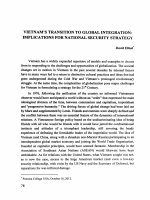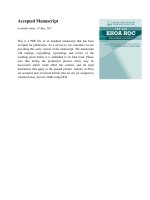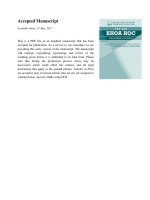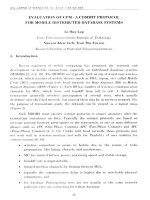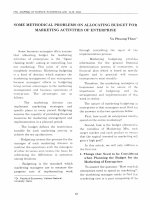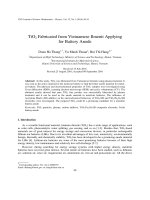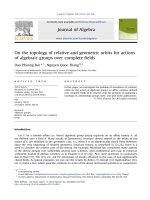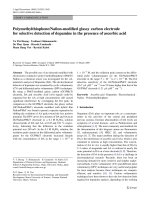DSpace at VNU: TiO2 Fabricated from Vietnamese Ilmenit Applying for Battery Anode
Bạn đang xem bản rút gọn của tài liệu. Xem và tải ngay bản đầy đủ của tài liệu tại đây (638.69 KB, 7 trang )
VNU Journal of Science: Mathematics – Physics, Vol. 32, No. 3 (2016) 49-55
TiO2 Fabricated from Vietnamese Ilmenit Applying
for Battery Anode
Doan Ha Thang1,*, Vu Manh Thuan2, Bui Thi Hang2,*
1
Department of High Technology, Ministry of Science and Technology, Hanoi, Vietnam
2
International Institute for Materials Science,
Hanoi University of Science and Technology, Hanoi, Vietnam
Received 15 July 2016
Revised 25 August 2016; Accepted 09 September 2016
Abstract: In this study, TiO2 was fabricated from Vietnamese ilmenite using plasma treatment. It
was used as the active material in the metal-air battery to find the better anode material for metalair battery. The physical and electrochemical properties of TiO 2 samples were investigated using
X-ray diffraction (XRD), scanning electron microscopy (SEM) and cyclic voltammetry (CV). The
obtained results showed that pure TiO2 fine powder was successfully fabricated by plasma
treatment and it can be used as the anode material in metal-air batteries. The influence of
Acetylene Black (AB) additive on the electrochemical behaviors of TiO 2/AB and TiO2/Fe2O3/AB
electrodes were investigated. The prepared TiO2 could be a promising candidate for a metal/air
battery anode.
Keywords: TiO2 particles, plasma, carbon additive, TiO2-Fe2O3/AB composite electrode, Fe/air
battery anode.
1. Introduction
As a versatile functional material, titanium dioxide (TiO2) has a wide range of applications, such
as solar cells, photocatalytic water splitting, gas sensing, and so on [1-3]. Besides that, TiO2-based
materials are of great interest for energy storage and conversion devices, in particular rechargeable
lithium ion batteries (LIBs). Due to its excellent advantages of low cost, nontoxicity, environmentally
benign, thermally and chemically stability, TiO2 has been developed to be a promising anode material
for LIBs [4]. Lithium-ion batteries are some of the most promising batteries because of their high
energy density, low maintenance and relatively low self-discharge [5-7].
However, during searching for energy storage systems with higher energy density, metal/air
batteries have received great interest. Several metal/ air batteries have been studied, such as lithiume
air, sodiume air, zince air, magnesiume air, aluminume air, iron air and potassiume air. All the above
_______
Corresponding author. Tel.: 84-4-38680787
Email: ,
49
50
D.H. Thang et al. / VNU Journal of Science: Mathematics – Physics, Vol. 32, No. 3 (2016) 49-55
batteries have very high theoretical energy density about 2- 10 folds higher than that of lithium-ion
batteries [8-9].
Therefore, in the present study, TiO2 obtained from Vietnamese ilmenite using plasma treatment
was used as the active material of negative electrodes for Fe-air batteries. Nanocarbon was used as an
additive material for improving the electrical conductivity and the cycleability of TiO 2 electrode. The
electrochemical properties of the prepared TiO2 and the effect of carbon on the electrochemical
properties of TiO2 electrode were investigated to find the best suitable material for Fe-air
battery anode.
2. Experimental
Refined ilmenite (Ninh Thuan - Vietnam) was treated by plasma to obtain the relative pure TiO2. It
was used as the active material for preparing negative electrodes in Fe-air battery.
Acetylene black (AB, Denki Kagaku Co. Ltd.) was used as the carbon additive to enhance the
conductivity of TiO2/C electrodes. All chemicals purchased from commercial sources were analytical
grade and were used as received without additional reprocessing.
The titanium compound obtained was identified to be TiO2 by X-ray diffraction (XRD). The
morphology of the as-prepared TiO2 powder was observed scanning electron microscopy (SEM).
To determine the electrochemical behavior of as-fabricated TiO2, we prepared two electrode
sheets, containing and free TiO2. The electrode sheeting free TiO2 was prepared by mixing 45 wt.%
TiO2 and 10 wt.% polytetrafluoroethylene (PTFE; Daikin Co.), followed by rolling. The electrode
sheeting containing Fe2O3 was fabricated at a ratio of TiO2:Fe2O3: PTFE = 45:45:10 wt. %. Each
electrode was formed into a 1 cm-diameter pellet.
To obtain the effect of carbon additive, the TiO2/AB and TiO2/Fe2O3/AB electrode sheets were
prepared by the same procedure with the mixing ratio of TiO2:AB: PTFE = 45:45:10 wt. % and
TiO2:Fe2O3:AB:PTFE = 40:40:10:10 wt. %. Bothe TiO2/AB and TiO2/Fe2O3/AB electrodes were made
into a pellet of 1 cm diameter.
To investigate the electrochemical properties of prepared TiO2 and effect of AB additive on the
electrochemical properties of the TiO2/AB and TiO2/Fe2O3/AB electrodes, cyclic voltammetry (CV)
were carried out in three-electrode glass cells with TiO2 or TiO2/Fe2O3 or TiO2/AB or TiO2/Fe2O3/AB
electrode as the working electrode, Pt mesh as the counter electrode, and Hg/HgO as the reference
electrode. The electrolyte was 8 mol dm-3 KOH aqueous solution. CV measurements were taken at a
scan rate of 5 mV s−1 and within a range of −1.3 V to −0.1 V. In all electrochemical measurements, we
used fresh electrodes without pre-cycling.
3. Results and discussion
Figure 1 shows the XRD pattern of the TiO2 fabricated from Vietnamese ilmenite using plasma
treatment. It can be seen that the characteristic peaks for TiO2 are consistent with the database in CSD
file (ICSD No.24276) and it revealed that the resultant particles were pure TiO2.
To obtain the morphology and particles size of TiO2 fabricated from Vietnamese ilmenite using
plasma treatment, SEM measurement was carried out and the result is showed in Figure 2. It is clear
that the TiO2 particles have similar morphology and shape and they look like the balls. Their particle
size is relative uniform and less than 500 nm.
D.H. Thang et al. / VNU Journal of Science: Mathematics – Physics, Vol. 32, No. 3 (2016) 49-55
Figure 1. XRD pattern of the TiO2
500 nm
Figure 2. SEM image of TiO2
100 nm
Figure 3. SEM image of Acetylene black (AB)
51
52
D.H. Thang et al. / VNU Journal of Science: Mathematics – Physics, Vol. 32, No. 3 (2016) 49-55
Figure 3 depicts the SEM image of Acetylene black (AB). The average diameter of AB is about
100 nm. The shape of AB is relative uniform and particles also look like the balls. It is used as an
additive to electrode to enhance the conductivity of TiO2 and TiO2-Fe2O3 electrodes. When TiO2 is
used as electrode active material, in the present of AB additive, TiO2/AB and TiO2-Fe2O3/AB
electrodes are expected to provide the better cycleability and the higher capacity than TiO2 electrode.
Figure 4. Cyclic voltammogams of a TiO2 composite electrode with TiO2:PTFE = 90:10 wt.%
in KOH aqueous solution.
The cyclic voltammograms of the TiO2 electrode are shown in Figure 4. Several peaks were
observed, including the oxidation peaks at around –0.95V (a0), –0.8V (a1) and –0.65V (a2) on the
forward scan and the corresponding reduction peaks at around –0.95V (c1) and –1.1 V (c2) on the
backward scan. The a0 peak was attributed to oxidation of Ti to Ti(I) and c3 peak was hydrogen
evolution. The reduction peak c2 was separated from hydrogen evolution (c3). The first and second
anodic peaks (a1 and a2) can be attributed to oxidation of Ti to Ti (II) (a1) and Ti (II)/Ti (III) and Ti
(III)/Ti (IV) (a2) while cathodic peaks (c1 and c2) correspond to the reduction of Ti (IV)/Ti (III) and Ti
(III)/Ti (II) (c1) and Ti (II)/Ti (c2), respectively. Thus, a1 and c2 correspond Ti/Ti(II) redox couple
while a2 and c1 correspond Ti (II)/Ti (III) and Ti (III)/Ti (IV) redox couple. With further cycling, the
redox current under these peaks was decreased. This could be ascribed to the passive film nature of the
Ti4+ active material forming during cycling.
To make clear the effect of the cacbon additive on the electrochemical behavior of the TiO2
electrode, CV measurement was carried out for the TiO2/AB electrode, and the result is presented in
Figure 5. The redox couples of Ti/Ti (II) and Ti (II)/Ti (III) occurred at around −0.85 V (a1) on the
oxidation and −0.9 V (c1) on the reduction process. The anodic peak a0 was observed at around -0.95V
and the cathodic peak c2 was unobservable. Comparison with CV profiles of the TiO2 composite
electrode free AB additive (Fig. 4), it can be seen that in the case of TiO 2/AB electrode (Fig. 5) only
one couple peak of Ti /Ti (II) and Ti (II)/Ti (III) (a1/c1) occurred but the current under these peaks was
larger than that of the TiO2 electrode. However, the anodic peak a1 occurred at more negative potential
than that at TiO2 electrode. This could be ascribed to the passive film nature of the Ti4+ active material
D.H. Thang et al. / VNU Journal of Science: Mathematics – Physics, Vol. 32, No. 3 (2016) 49-55
53
formed during discharge process, which would inhibit the Ti/Ti(II), and Ti (II)/Ti (III) redox couples,
and resulting in an increased overpotential. Thus, the present of AB in TiO2 electrode might cause the
shift of redox peaks toward to more negative potentials and lead to the overlap of hydrogen evolution
c3 on the reduction peak c2. With further cycling, the current under these peaks gradually decreased but
the decreasing rate at TiO2/AB electrode was smaller than that at TiO2 electrode. The difference in the
CV profiles of TiO2 and TiO2/AB composite electrodes revealed the influence of the AB additive on
the electrochemical properties of TiO2 electrode.
These results suggest that the cycleability of TiO2/AB composite electrode was improved
significantly by AB additive.
Figure 5. Cyclic voltammogams of a TiO2/AB composite electrode with TiO2:AB:PTFE = 45:45:10 wt.%
in KOH aqueous solution.
Figure 6. Cyclic voltammogams of a Fe2O3-TiO2 composite electrode with Fe2O3:TiO2:PTFE = 45:45:10 wt.%
in KOH aqueous solution.
54
D.H. Thang et al. / VNU Journal of Science: Mathematics – Physics, Vol. 32, No. 3 (2016) 49-55
To find the better electrode material for Fe-air battery anode, the mixture of Fe2O3 (Walko,
nanoparticles) and TiO2 were used as the active material and, their CV result is presented in Fig. 6.
Only a small redox couple peak a1, c2 was observed at around −0.80 V (a1) and −0.9 V (c2) together
with hydrogen evolution peak c3 on TiO2-Fe2O3 electrode and the current under these peaks is rather
small. Comparison with CV result of TiO2 electrode (Fig. 4), it is clear that the electrode using
prepared TiO2 showed the better redox reaction than TiO2-Fe2O3 (Fig. 6). It may be due to the
commercial Fe2O3 have smaller particle size than TiO2, consequently with the same wt.% of binder,
the contact between the particles in TiO2-Fe2O3 electrode was loosen and thus it gave larger internal
resistance than TiO2 electrode.
Figure 7. Cyclic voltammogams of a Fe2O3-TiO2/AB composite electrode with
Fe2O3:TiO2:AB:PTFE=40:40:10:10 wt.%
Figure 7 show in the cyclic voltammograms of the TiO2-Fe2O3/AB composite electrode. Two
oxidation peaks were observed at around −0.8V (a1) and −0.5 V (a2) while only one reduction peak
occurred around −1.1V (c1), respectively. The reduction peak c2 was unobservable due to the
superimposed in hydrogen evolution (c3).
Comparison CV results of TiO2-Fe2O3/AB (Fig. 7) and TiO2-Fe2O3 (Fig. 6) electrodes we can see
clearly the positive effect of AB on the cycleability and cycle performance of TiO2-Fe2O3 electrode.
In the case of TiO2/AB electrode (Fig. 5), although AB additive improved its cycleability but
TiO2-Fe2O3/AB showed better cycleability and higher capacity as evidenced by the occurring of two
oxidation peaks a1, a2 instead of only oxidation peak a1 in TiO2/AB electrode and provided larger
redox current than TiO2/AB electrode.
4. Conclusion
TiO2 fine powder was successfully fabricated from Vietnamese ilmenite using plasma treatment.
The SEM results showed that small TiO2 particles aggregated to form large particles in micrometer
scale. The electrochemical properties of prepared TiO2 in alkaline solution were investigated. The
D.H. Thang et al. / VNU Journal of Science: Mathematics – Physics, Vol. 32, No. 3 (2016) 49-55
55
obtained results revealed that these TiO2 materials can be used for the anode in metal-air batteries. AB
additive showed the significantly effects on the electrochemical properties of both the TiO2/AB and
the TiO2-Fe2O3/AB electrodes improving the cycleability and reaction rate of TiO2. With further
investigation to find the optimal preparation condition, the TiO2 fine powder with uniform particles is
expected to be a potential candidate for use in metal/air battery anode.
Acknowledgments
This research is funded by Vietnam National Foundation for Science and Technology
Development (NAFOSTED) under grant number 103.02-2014.20 and by Ministry of Science and
Technology (MOST): “Cooperative research on applying plasma technology in fabrication of high
quality TiO2 from ilmenite Vietnam”.
References
[1] B. O'Regan, M. Gratzel, A Low-Cost, High-Efficiency Solar Cell Based on Dye-sensitized Colloidal TiO2 Films.
Nature 353 (1991) 737.
[2] S. U. M. Khan, M. Al-Shahry, W. B. Ingler, Efficient Photochemical Water Splitting by a Chemically Modified
n-TiO2, Science 297 (2002) 2243.
[3] X. Chen, S. S. Mao, Titanium Dioxide Nanomaterials: Synthesis, Properties, Modifications, and Applications,
Chem. Rev. 107 (2007) 2891.
[4] D. Deng, M. G. Kim, J. Y. Lee, J. Cho, Green Energy Storage Materials: Nanostructured TiO 2 and Sn-Based
Anodes for Lithium-Ion Batteries, Energ. Environ. Sci. 2 (2009) 818.
[5] B. Luo, S. Liu, L. Zhi, Chemical approaches toward graphene-based nanomaterials and their applications in
energy-related areas, Small 8 (2012) 630.
[6] D. Liu, G. Cao, Engineering nanostructured electrodes and fabrication of film electrodes for efficient lithium ion
intercalation, Energy Environ. Sci. 3 (2010) 1218.
[7] P. G. Bruce, B. Scrosati, J. M. Tarascon, Nanomaterials for rechargeable lithium batteries, Angewandte Chemie
Int. Ed. 47 (2008) 2930.
[8] D. Linden, T.B. Reddy, Handbook of Batteries, McGraw-Hill Professional, 2001.
[9] Z. Xin, W.Xin-Gai, X. Zhaojun, Z. Zhen, Recent progress in rechargeable alkali metal–air batteries, Green
Energy & Environment 1 (2016) 4.


